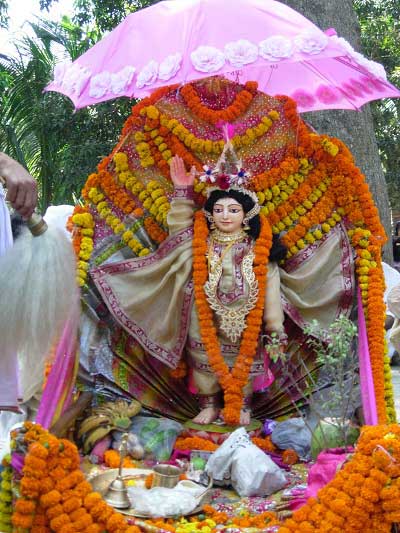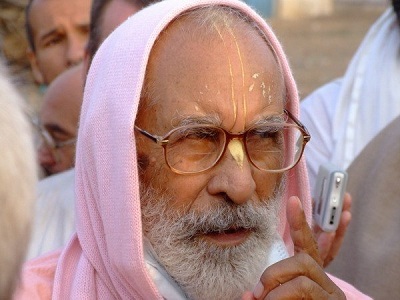Sri Srimad Bhaktivedanta Narayana Gosvami Maharaja
Sri Devananda Gaudiya Matha, Navadvipa: Mar.12, 2000
Sri Devananda Gaudiya Matha, Navadvipa: Mar.12, 2000
 Sri Caitanya Mahaprabhu appeared in Navadvipa and performed His pastimes there. It is said that after these pastimes were completed, He took sannyasa and went to Puri. Later He went to South India, met Srila Ramananda Raya, and revealed to him His form as Sri Sri Radha and Krsna combined – Rasaraja-mahabhava. This form of Rasaraja-mahabhava is also described in the Srimad-Bhagavatam, as the pastimes of Radha and Krsna. Krsna is Rasaraja (the king of all tasters of transcendental mellows) and Radhika is Mahabhava-svarupa (the quintessence of transcendental loving emotions towards Krsna).
Sri Caitanya Mahaprabhu appeared in Navadvipa and performed His pastimes there. It is said that after these pastimes were completed, He took sannyasa and went to Puri. Later He went to South India, met Srila Ramananda Raya, and revealed to him His form as Sri Sri Radha and Krsna combined – Rasaraja-mahabhava. This form of Rasaraja-mahabhava is also described in the Srimad-Bhagavatam, as the pastimes of Radha and Krsna. Krsna is Rasaraja (the king of all tasters of transcendental mellows) and Radhika is Mahabhava-svarupa (the quintessence of transcendental loving emotions towards Krsna).
In Navadvipa, Sri Gauranga performed sakhya-bhava pastimes with His friends in His naravata, human-like, lila. Some people say that after taking sannyasa in Navadvipa, He left and performed higher pastimes in Puri. After that, on the bank of Godavari He met Ramananda Raya and learned how to taste Krsna in a still more intense mood of separation. It is not actually true, however, that Puri and Godavari are higher than Navadvipa, nor is it true that Sri Sacinandana Gaurahari ever leaves Navadvipa.
It is said that Mahaprabhu was able to taste what He came to this world to taste – only after He met Raya Ramananda, who is Visakha-devi in Krsna-lila. He learned from him how to taste radha-bhava. Do you know why He learned from Ramananda Raya instead of Srila Svarupa Damodara, who is Lalita-devi in krsna-lila? Lalita devi is the first expansion of Radharani and Visakha-devi is the second expansion. But Visakha's birthday is the same as that of Srimati Radharani, so her nature is the same. She has practically the same qualities and the same form. Krsna could not be taught by Lalita-devi because her mood is pragalba, bold and outspoken. Srimati Radhika and Srimati Visakha, although also left-wing gopis, are the same as each other – madhya-nayika, heroines who are a mixture of pragalbha and mrdvi (sweet and gentle). Therefore. Mahaprabhu had to learn from Ramananda Raya how to taste Radha-bhava. Because it was at Godavari that Mahaprabhu learned to taste that Radha-bhava, some say that Godavari is higher than Navadvipa.
But this is not so. Navadvipa itself is the highest abode, and it includes Godavari and Jagannatha Puri. We can understand this by a comparative study of aisvarya-mayi-lila and madhurya-mayi-lila ('mayi' means 'consisting of'). What is the difference between aisvarya and madhurya? Aisvarya-lila are displays of opulence which cannot be performed by any human being, whereas madhurya-lila are those pastimes which appear human-like, even if there is a great display of opulence. If there is no opulence, activities are simply mundane. So there may be opulence in madhurya-mayi-lila, but that lila still appears sweet and human-like, and so it is called madhurya. Whether opulence is clearly present or not, in madhurya-lila there does not seem to be opulence.
As we see from Krsna's lila, there is more aisvarya in Vrndavana than there is in Vaikuntha, Dvaraka, or Mathura. However, it is covered by so much sweetness that the opulence cannot be tasted. [For clarification an example is given of salt and sugar: There are four cups. The first has 1 ounce of salt and no sugar. The second one has 2 ounces of salt and 2 ounces of sugar. The third has 3 ounces of salt and 6 ounces of sugar. And the fourth has 4 ounces of salt and 100 lbs. of sugar. Although the fourth cup has more salt, one cannot taste it because of all the sugar.] In Goloka Vrndavana the opulence is covered.
 Krsna's madhurya-lila includes aisvarya. When Krsna lifted Govardhana Hill, the cowherd boys thought that He must be getting tired. They considered, "We should also help to hold up Govardhana, with our sticks." Others thought, "Because of Nanda Maharaja's austerities, Lord Narayana entered Krsna's body. It is actually Narayana who is holding up Govardhana." The gopis were glaring upon Govardhana and said to him, "If you fall down on Krsna, we will curse you." So these are human-like pastimes. When Krsna was a baby He showed His mother His universal form, and everything was there within His mouth – all incarnations, all universes, all elements, all senses, and so forth. Despite this, Yasoda-maiya could not conceive that her son is God.
Krsna's madhurya-lila includes aisvarya. When Krsna lifted Govardhana Hill, the cowherd boys thought that He must be getting tired. They considered, "We should also help to hold up Govardhana, with our sticks." Others thought, "Because of Nanda Maharaja's austerities, Lord Narayana entered Krsna's body. It is actually Narayana who is holding up Govardhana." The gopis were glaring upon Govardhana and said to him, "If you fall down on Krsna, we will curse you." So these are human-like pastimes. When Krsna was a baby He showed His mother His universal form, and everything was there within His mouth – all incarnations, all universes, all elements, all senses, and so forth. Despite this, Yasoda-maiya could not conceive that her son is God.
Sri Caitanya Mahaprabhu is Krsna Himself, and His dhama, Sri Navadvipa, is Vrndavana itself. In Navadvipa He was known as Saci-putra and Sacinandana, the son of Saci-mata and Jagannatha Misra. He was also called Visnupriya-pati, the husband of Srimati Visnupriya-devi. Practically no one there knew that He is the Supreme Lord.
Two of His friends at that time were Jagadananda Pandita and Svarupa Damodara. They were his fellow-students when He attended the school of Gangadasa Pandita, and they all performed their madhurya-lila there. As there are so many human learned scholars or panditas, the residents of Navadvipa considered Saci-putra to be Nimai Pandita, a very good human pandita.
There is no aisvarya in this name Nimai Pandita. It is naravata, human-like. When Kesava Kasmiri, the digvijaya (challenging scholar), came to defeat the panditas of Navadvipa, they decided to make Nimai Pandita their representative. They considered Him to be just a boy. Therefore, if He would lose, they could then say, "He's just a boy." And if He would win, they could consider it a great victory for Navadvipa that their boy-scholar was successful.
Being fellow-students in Gangadasa Pandita's school, Jagadananda Pandita and Nimai Pandita used to have friendly arguments about logic. Sometimes they would argue about the definition of mukti. Jagadananda Pandita would quote the verse beginning, "Atyantya dukha nivritti – Liberation means to be delivered from the miseries of maya." But Nimai Pandita would say, "No. The real definition of mukti is: 'Mukti hitva anyata rupam, svarupena vyavastiti – Mukti is that condition in which one realizes his own svarupa and the svarupa of Krsna, and he realizes his relationship with Krsna. Liberation from all false identifications is only possible when one knows his real identification. When one surrenders to the lotus-feet of Radha and Krsna and serves Them with one's transcendental body and senses, that is mukti. Otherwise mukti is only partial.'" So this is nara-lila – human-like friends arguing together.
In Jagannatha Puri, on the other hand, there were so many opulent pastimes, which everyone knew could not be performed by a human being. For example, when Mahaprabhu jumped in the ocean and was caught in the fisherman's net, His body became elongated and all His joints were separated by eight inches. This is opulence, and this is very deep and hard to understand. After Mahaprabhu completed his talks with Ramananda Raya, He tasted the fruits in Gambhira and only three-and-one-half persons were allowed to enter there – Sri Ramananda Raya, Sri Svarupa Damodara, Sikhi Mahiti, and his sister, Srimati Madhavi devi.
Dvaraka is full of opulence. There are so many palaces, elephants, horses, and chariots there. Similarly, in Puri there was so much veneration by all Mahaprabhu's devotees, and all were fearful to make proposals to Him. In Navadvipa, on the other hand, Kolaveca Sridhara would have arguments with Nimai Pandita – and Nimai would even steal his vegetables.
In Vraja, Sri Krsna is considered an ordinary cowherd boy. In Navadvipa, Sri Caitanya Mahaprabhu is considered an ordinary brahmana's ordinary son. No one in Navadvipa could conceive of Him being called Mahaprabhu. Only when He went to Puri did He begin to be called Mahaprabhu. In Navadvipa He sucked the breast of Saci-devi. He played with the girls who were worshiping Siva-linga to get a good husband. He also sometimes behaved as a mischievous student. His lila, therefore, is called madhurya-mayi-lila.
Someone may object to this statement, considering that He manifested as Nrsimhadeva and Varaha in Navadvipa. This is true, but hardly anyone saw this. Practically all the devotees always thought He was simply Saci-nandana. Only a few were in the mood of worship, like Murari Gupta (who is Hanuman in Rama-lila) or Srivasa Pandita (who is Narada Muni in Krsna-lila), understood Him as the Supreme Lord.